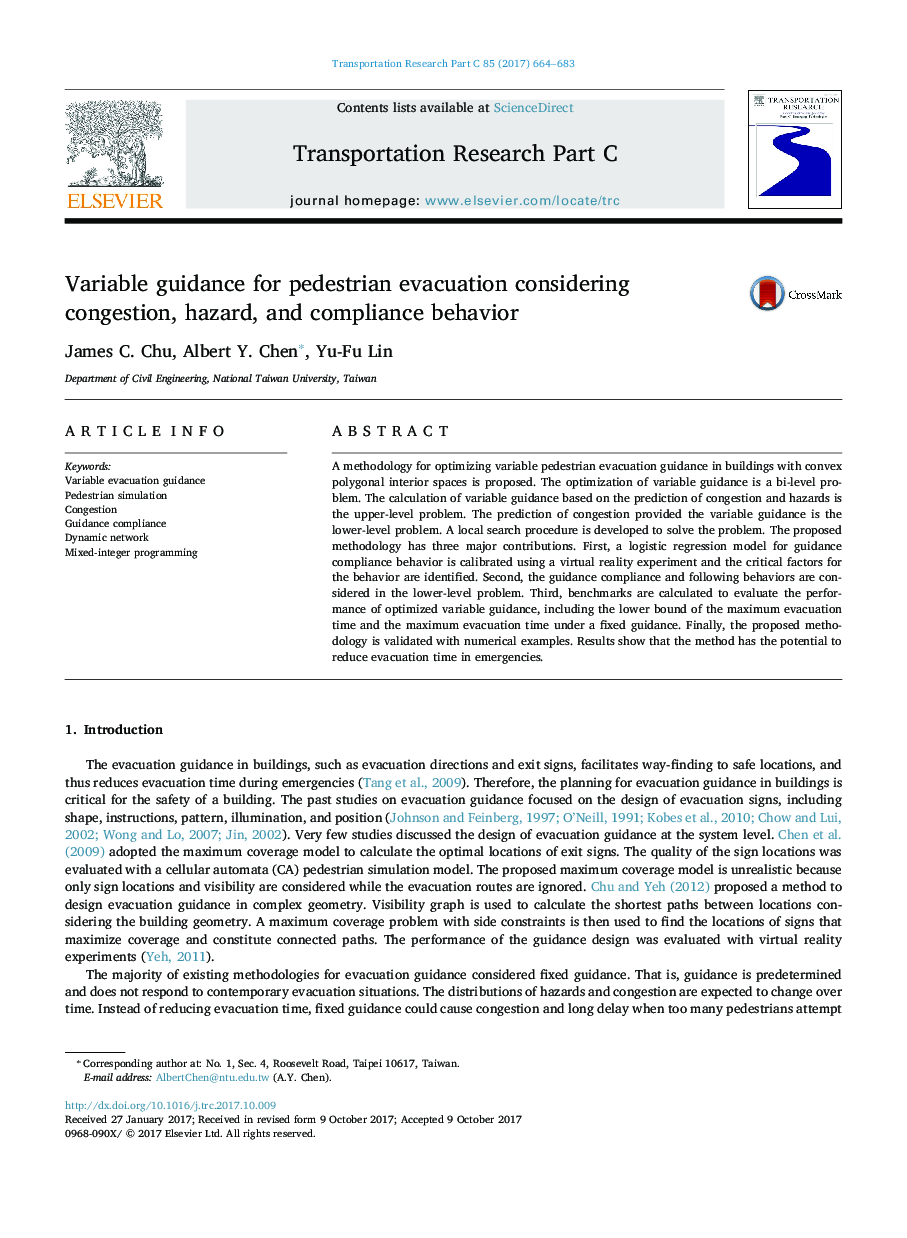| کد مقاله | کد نشریه | سال انتشار | مقاله انگلیسی | نسخه تمام متن |
|---|---|---|---|---|
| 6936318 | 1449663 | 2017 | 20 صفحه PDF | دانلود رایگان |
عنوان انگلیسی مقاله ISI
Variable guidance for pedestrian evacuation considering congestion, hazard, and compliance behavior
ترجمه فارسی عنوان
هدایت متغیر برای تخلیه عابر پیاده با توجه به احتقان، خطر و رفتار انطباق
دانلود مقاله + سفارش ترجمه
دانلود مقاله ISI انگلیسی
رایگان برای ایرانیان
کلمات کلیدی
هدایت متغیر تخلیه، شبیه سازی پیاده روی، جابجایی، پیروی از راهنمایی، شبکه دینامیک برنامه ریزی عدد صحیح مختلط،
ترجمه چکیده
یک روش برای بهینه سازی راهنماهای تخلیه عابر پیاده در ساختمان ها با فضاهای داخلی چند ضلعی محدب پیشنهاد شده است. بهینه سازی هدایت متغیر یک مشکل دو سطحی است. محاسبه هدایت متغیر بر مبنای پیش بینی احتقان و خطرات، مشکل بالای سطح است. پیش بینی احتقانات ارائه شده متغیر هدایت سطح پایین مشکل است. روش جستجوی محلی برای حل مشکل توسعه داده شده است. روش پیشنهادی دارای سه بخش عمده است. ابتدا مدل رگرسیون لجستیک برای رفتار انطباق هدایت با استفاده از یک آزمایش واقعیت مجازی و عوامل حیاتی برای رفتار شناسایی می شود. دوم، رعایت دستورالعمل و رفتارهای زیر در سطح پایین تر مورد توجه قرار می گیرد. سوم، معیارهای محاسبه شده برای ارزیابی عملکرد هدایت متغیر بهینه، از جمله حد پایین تر از حداکثر زمان تخلیه و حداکثر زمان تخلیه تحت راهنمایی ثابت است. در نهایت، روش پیشنهادی با نمونه های عددی معتبر است. نتایج نشان می دهد که این روش می تواند زمان تخلیه را در موارد اضطراری کاهش دهد.
موضوعات مرتبط
مهندسی و علوم پایه
مهندسی کامپیوتر
نرم افزارهای علوم کامپیوتر
چکیده انگلیسی
A methodology for optimizing variable pedestrian evacuation guidance in buildings with convex polygonal interior spaces is proposed. The optimization of variable guidance is a bi-level problem. The calculation of variable guidance based on the prediction of congestion and hazards is the upper-level problem. The prediction of congestion provided the variable guidance is the lower-level problem. A local search procedure is developed to solve the problem. The proposed methodology has three major contributions. First, a logistic regression model for guidance compliance behavior is calibrated using a virtual reality experiment and the critical factors for the behavior are identified. Second, the guidance compliance and following behaviors are considered in the lower-level problem. Third, benchmarks are calculated to evaluate the performance of optimized variable guidance, including the lower bound of the maximum evacuation time and the maximum evacuation time under a fixed guidance. Finally, the proposed methodology is validated with numerical examples. Results show that the method has the potential to reduce evacuation time in emergencies.
ناشر
Database: Elsevier - ScienceDirect (ساینس دایرکت)
Journal: Transportation Research Part C: Emerging Technologies - Volume 85, December 2017, Pages 664-683
Journal: Transportation Research Part C: Emerging Technologies - Volume 85, December 2017, Pages 664-683
نویسندگان
James C. Chu, Albert Y. Chen, Yu-Fu Lin,
